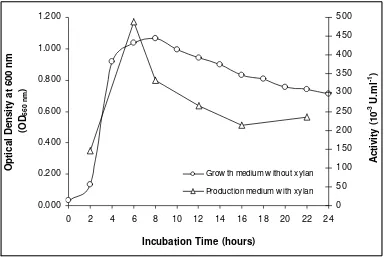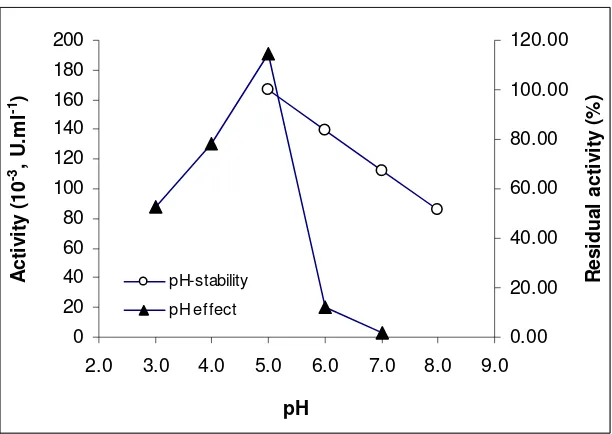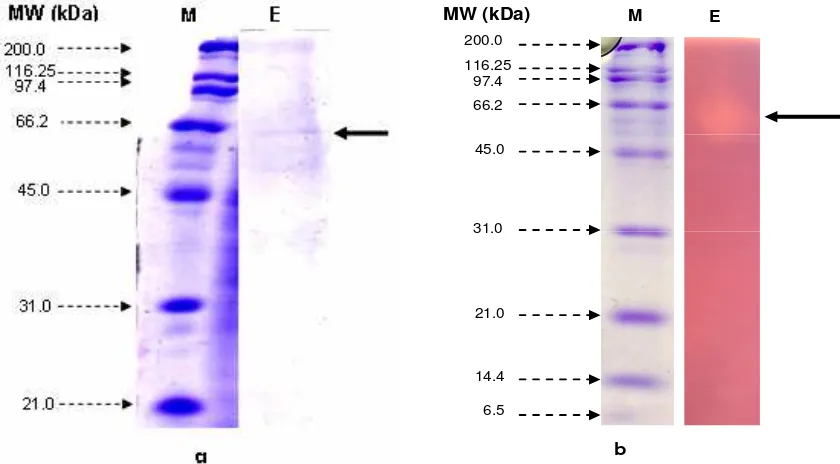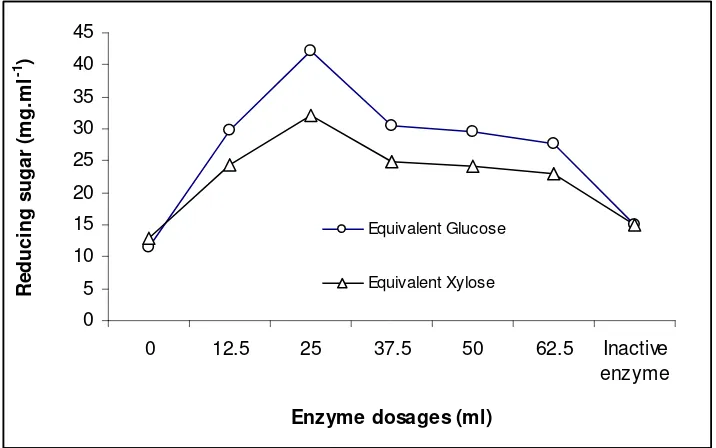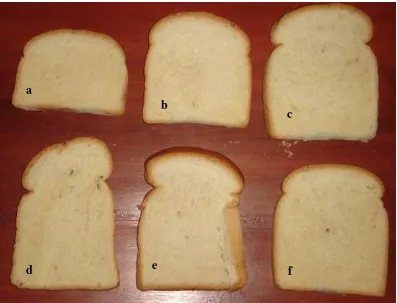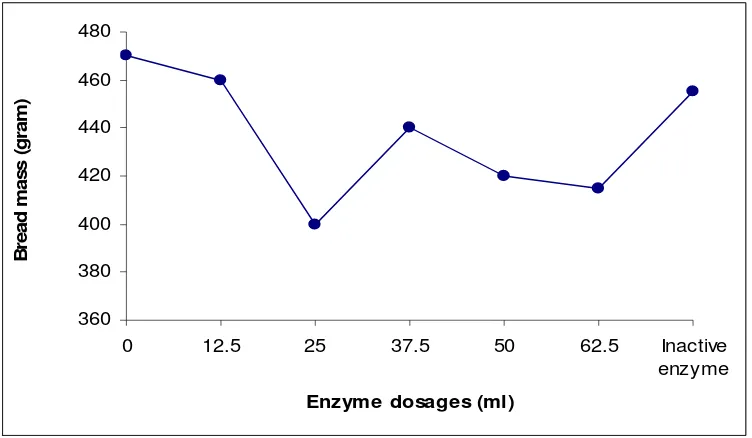ISOLATION and SOME PROPERTIES of XYLANASE from
SOIL-TERMITE GUTS and INFLUENCE of ENZYMES in BAKING
Anak Agung Istri Ratnadewi
*, Agung Budi Santoso, Muhammad Naqib
Department of Chemistry, Faculty of Mathematic and Natural Sciences, The University of Jember at Kampus Tegalboto, Jember, East Java, Indonesia To whom correspondence should be addressed. E-mail: [email protected]
Abstract
The bacteria which has been isolated from gut of soil-termites that captured in around
of College The University of Jember can secretes of xylanolytic enzymes. These enzyme
acts as catalyst in hydrolysis of xylan synergically. The xylanolytic enzymes showed
activities toward oat-spelts xylan was 4.78 U (referred as
endo-β-1,4-D-xylanases),
whereas activities toward
p-nitrophenyl derivative substrates were 1.94 U (referred as
α-L-arabinofuranosidases) and 2.64 U (referred as
α-D-glucuronidases). The xylanolytic
enzymes did not showed any activities of both exo-β-1,4-D-xylosidases and acetyl-xylan
esterases. Attemp to purify of enzyme endo-β-1,4-D-xylanases also has been performed.
Purification have so far been carried out were partially by ion-exchange column
chromatography. Activity
endo-β-1,4-D-xylanases was determined by DNS method,
whereas the protein content was determined by Bradford method. The highest
releasing-fractions of enzyme
endo-β-1,4-D-xylanase on ion-exchange column
chromatography obtained at saturation of 0.5 M NaCl with specific activity 1.62 U.mg
-1.
Enzyme has an optimum pH and temperature at 5.0 and 40
oC, respectively. These
enzyme were stable at temperature of 40
0C for four hours and range of pH 5.0 -8.0. The
relative molecular mass possessed of
endo-β-1,4-D-xylanases is around of
45,000-66,200 Dalton by SDS-PAGE, whereas analysis of zymogram using SDS-Xylan-Page used
to confirm that it contained
endo-β-1,4-D-xylanase activity at the range of
45,000-66,200 Dalton. These analyses revealed that enzymes could degrade oat-spelts xylan as
substrates. Based on their both activity and characteristics, the potential of
endo-β-1,4-D-xylanases as technological aids in baking was clearly demonstrated. Baking trials were
performed with five wheat dough prepared with 0.0 ml (control), 12.5 ml, 25.0 ml, 37.5
ml, 50.0 ml, and 62.5 ml enzyme volume against 2,500 g wheat flour. In bread baking,
endo-β-1,4-D-xylanase produce an effect that can result in many desirable benefits
including increased of physico-chemical performance (moisture, reducing-sugar contents
equivalent with glucose and xylose, mass, product volume, porosity and texture),
improved crumb softness and organoleptic aspects (shelf-life, taste and aroma).
The presence of
endo-β-1,4-D-xylanase at volume 25.0 ml in the dough led to
improvements in the breadmaking quality (i.e. product volume, porosity, and
reducing-sugar content) on breads compared to control.
I. Introduction
Termites (order Isoptera) have the capability to digest hemicellulosic materials, due to the enzyme activity produced by microorganisms including flagellated protists, yeasts, and bacteria in its digestive tract1.
Hemicellulosic materials such as xylan, is made up of a main chain of β-1,4- linked xylopyranose residues that is most often replaced by α-linked units of arabinofuranose and methylglucuronic acid. When ingested by the termites, this complex polysaccharide must be hydrolyzed to sugar monomers to realize metabolic input2. Xylan,
as the most abundant hemicellulose, can degraded enzymatically. Complete biodegradation of xylan requires endo-β -1,4-D-xylanase (E.C. 3.2.1.8), endo-β
-1,3-D-xylanase (E.C. 3.2.1.32), exo-β
-1,4-D-xylosidase (E.C. 3.2.1.37), exo-xylanase (E.C. 3.2.1.X), and several accessory enzymes, such as α-L-arabino-furanosidase (E.C. 3.2.1.55), α-D-glucuronidase (E.C. 3.2.1.139), acetyl-xylan esterase (E.C. 3.1.1.72), and fenolic acid esterases (ferrulic and p-coumaric acid esterase, 3.1.1.73), which are necessary for hydrolyzing various substituted xylan synergically3,4.
The main enzyme of xylan depolymerization is an endo-β
-1,4-D-xylanase (called -1,4-D-xylanase), which attacks the main chain of polymer. Xylanase from numerous termite-gut bacteria have been well documented and intensively studied2,5,6.
The use of bacterial xylanases for the hydrolysis of xylan is widely researched because of the importance of hydrolysis products (xylooligosaccharides and xylose) in fermentation processes for the production of fuel, chemicals, food and feed.
Xylanase depolymerize arabinoxylans (AX), and are already widely utilized in breadmaking7. The potential application of
xylanase in bakery, which was mainly to improve the quality of bread, was reported in recent years8.9.10. They can acts as
improver and effectively replace the usual
additives in baking technologies such as traditional emulsifiers, oxidants and malt12. While many researchers have investigated the utilization of xylanase from other sources in breadmaking, comparatively little has been done on the termite xylanases. Here we report isolation, partial purification and some biochemical properties of xylanase from gut of local-soil termites and its application on breadmaking.
II. Materials and Methods
Chemicals. Substrates for xylanolytic enzymes, such as oat-spelt xylan were purchased from Fluka-Biochemika (Weinheim, Germany), p-nitrophenyl-β
-D-xylopyranoside (pNPX) from MP Biomedicals, Inc. (Solor, OH, USA), both p-nitrophenyl-α -L-arabinofuranoside (pNPA) and p -nitrophenyl-β-D-glucuronide (pNPG) were from Sigma-Aldrich, Inc. (St. Louis, MO, USA), both p-nitrophenyl-acetate (pNPAc) and p-nitrophenol were from ICN Biomedicals, Inc. (Aurora, OH, USA), albumin of bovine serum (BSA) from Fluka-Biochemika (Weinheim, Germany), Toyopearl®DEAE-650M from Tosoh Corp.
(Tokyo, Japan), protein molecular weight standards (p-6649) from Molecular Probes, Inc. (Eugene, OR, USA). All chemicals and reagents used were of analytical- and electrophoresis grade.
Enzyme Source. Local-soil termites were collected from an aerial nest and the mature workers removed from soil material in the laboratory. Head and thorax were discarded and the abdomen was used. After the exterior surface of the termite had been extensively rinsed sequential with distilled water and physiological salt solution, the whole-guts were ruptured using Dounce tissue homogenizer. The suspension of guts were diluted in physiological salt solution to 10-7 and stored at 0 – 40C until used.
An isolate which produced a widest clear zone on xylan medium was isolated13. For the production of xylanolytic enzymes, an isolate was grown on medium containing 1% oat-spelt xylan. Xylanolytic activity of bacteria was determined by the method that mentioned in assay procedures.
Determination of Xylanolytic Activity (Assays). Activity of xylanase was determined based on releasing of reducing sugars from oat-spelt xylan. The assay mixture of 200 µl total volume containing
enzyme and 500 mg substrate in 50 mM McIlvaine buffer (pH 5.0) was incubated for 60 minutes at 40oC. Released reducing
sugars were determined as xylose after termination the reaction with dinitrosalicylic acid reagent and boiling for 15 minutes. Absorbance was measured at 550 nm13. 1 Unit of xylanase is defined as the amount of enzyme which is capable of liberating from 1
µmole xylan equivalents of xylose in 1
minute for 1 ml of enzyme.
exo-β-1,4-D-xylosidase, α-L- arabino-furanosidase, α-D-glucuronidase, and acetyl-xylan esterase activities were determined by monitoring the release of p -nitrophenol from pNPX, pNPA, pNPG, and pNPAc, respectively. The reaction mixtures contained 900 µl of 0.9 M substrate
dissolved in 50 mM Tris-HCl buffer (pH 7.0). After the reaction mixtures were incubated at 40oC for 60 minutes, the reaction was stopped by adding 500 µl 0.4 M Na2CO3.
Absorbance was measured at 405 nm. 1 Unit of enzyme activity catalyzed the release of 1 µmole of p-nitrophenol per minutes in 1
ml of enzyme from their respective substrates14,15.
Production of Enzyme. Xylan-degrading enzymes were produced by incubating of inoculum for 12-hours at 300C. The inoculum was shaked at 200 rpm. 1% inoculum was moved to production-xylanolytic medium and then shaked for 12-hours at the same temperature. After harvested, the clear supernatant was collected after centrifugation at 16.2 (103) x g for 15 minutes.
Ammonium Sulfate Precipitation. The clear supernatant was collected and adjusted to 100% saturation by adding fine-solid ammonium sulfate [(NH4)2SO4]. This
was left overnight and the precipitate collected by centrifugation at 16.2 (103) x g
for 15 minutes. The precipitate was collected and dissolved in minimum volume of 50 mM McIlvaine buffer (pH 7.0) and dialyzed against the same buffer for 24-hours.
Ion-Exchange Chromatography. Dialyzed enzyme was loaded onto an anion-exchange Toyopearl®DEAE-650M column. Equilibration and elution were performed first with 50 mM McIlvaine buffer (pH 7.0) then with a linear salt gradient from 0.0 to 0.5 M NaCl. Fractions (2 ml) were collected and analyzed for both activities toward oat-spelt xylans and total protein. Active fractions were pooled and used for next studies.
Determination of Protein
Concentration. Protein was estimated by the Bradford method16. BSA was used as a
standard. The total protein of the chromatographic eluants were determined by monitoring the absorbance at 280 nm.
Effect of pH on Xylanase Activity and Stability. For determination of the pH optimum, the xylanase activity was measured by performing the assays at various pH values in the following buffer systems : 50 mM McIlvaine buffer (pH 4.0-6.0), 50 mM Tris-HCl (pH 8.0–9.0), 50 mM phosphate buffer (pH 6.0 -8.0), and Glysin-NaOH buffer (pH 9.0-10.0). For the pH-stability, the enzyme solutions were pre-incubated at optimum temperature for 1-hour in the buffer at various pH values between 3.0 and 10.0. After adjusting the mixtures to optimum pH, the residual activity was measured as the mentioned in assay procedures.
the enzyme solution was incubated at optimum temperature for 10-hours. Aliquot were removed at definite time intervals (2-hours) over the period of incubation. The residual activity was measured as the mentioned in assay procedures.
Molecular Weight Estimation. The molecular weight of xylanase was estimated by sodium dodecyl sulfate -polyacrylamide gel electrophoresis (SDS-PAGE)16 using 12% acrylamide. Proteins were stained with Coomassie®Brilliant blue R-250. The molecular probes protein molecular weight standards® (mw : 6.5, 14.0, 21.0, 30.0, 45.0, 55.0, 66.0, 97.4, 116.25, and 200.0) were used as molecular weight markers.
Detection of xylanase activity on native- polyacrylamide gel electrophoresis (Native-PAGE) was achieved after incorporating of 1% (w/v) oat-spelt xylan suspension in the resolving gel before addition of ammonium persulfate and polymerization. The gel was submerged in 0.1% (w/v) Congo-red solution for 30 minutes. The excess of dye was removed by washing in 1 M NaCl17.
Breadmaking Procedures. The bread dough formula consisted of hard-wheat flour with gluten content >12.5% (2,500 g), dehydrated yeast (25 g), salt (37.5 g), sugar (325 g), water (1,500 ml), and refined butter substitute (150 g). Partially purified enzyme was incorporated at the dosages 12.5 ml, 25.0 ml, 37.5 ml, 50.0 ml, and 62.5 ml. After mixed for 30 minutes, the doughs were divided (500 g), sheeted, rolled, and fermented for 80 minutes. Baking was performed at 180oC for 40 minutes. After
baking, bread loaves were allowed to cool at room temperature. Slicing and packaging were carried out after determination of loaf volume and weight.
Determination of Bread
Characteristics. Bread loaves from control and xylanase supplemented dough were weighed and volume were measured by seed displacement method18. Daily moisture
of the bread was calculated by drying the preweighed bread slice in an oven maintained at 1300C until constant weight18.
Moisture determination was stopped when the exterior performance of bread was changed. Sensory evaluation was done by the semi-expert panelists according to the description and preference evaluation. Apparent porosity was determined by visualization digitally using a digital camera. The bread crumbs (slice having 15 – 20 mm thickness) were subjected to texture profile analysis based on Reothex method. Reducing sugars were determined by Nelson-Somogyi method19.
III. Results and Discussion
Termite provides an abundance and diversity of symbiotic gut microbes including bacteria, archaea, and eucarya. A number of gut bacteria have been isolated from termite guts and were characterized as decomposers of lignocellulose, uric acid, and other aromatic compounds20. Glycosidases from termite bacterial have been studied with regard to their hydrolytic activities in deconstruction of hemicellulosic matter. Previous work suggests that microorganisms inhabiting the guts of termites may be unique to the particular ecosystem21.
Bacteria of Soil-Termite Guts. Based on the screening results, there are only five isolates (i. e. 6K, 6B, 11K, 11S, and 11B) that showed pale clearing zone formed around the colonies grown on xylanolytic media indicated the production of xylanolytic enzymes (Fig. 1).
Quantitatively, activities of five isolates were 0.13 U.ml-1, 0.073 U.ml-1, 0.092 U.ml-1,
0.082 U.ml-1 for 6K, 6B, 11K, and 11S,
Figure 2. Pattern of growth- and production curves of isolate 6K 0.000
0.200 0.400 0.600 0.800 1.000 1.200
0 2 4 6 8 10 12 14 16 18 20 22 24
Incubation Time (hours)
Op
ti
cal
D
en
s
it
y
at
60
0
n
m
(O
D66
0
n
m
)
0 50 100 150 200 250 300 350 400 450 500
Ac
ti
v
it
y
(
1
0
-3
U.
m
l
-1 )
Grow th medium w ithout xylan
Production medium w ith xylan
Assays of Xylanolytic Enzymes. The xylanolytic enzymes were detected
based assays using specific substrates, such as oat-spelt xylan and p-nitrophenyl derivatives. Isolate 6K showed activities of some enzymes, such as xylanase, (4.78 U),
α-L-arabinofuranosidase (1.94 U), α
-D-glucuronidase (2.64 U), but did not showed any activities of both exo-β-1,4-D-xylosidase acetyl-xylan esterase. However, these results shows that synergism of three xylanolytic enzymes isolate 6K can optimally
hydrolysis of xylan heteropolymer to simple hetero-monomer.
Bacillus sp. from termite infested soil were secreted only two xylanolytic enzymes, i. e.
β-xylanase and β-xylosidase15. Activity of
xylanase also was found in Paenibacillus
species isolated from the gut of a soil-feeding termite Sinocapritermes mushae6.
Generally, xylanolytic enzymes (enzyme mixture) interacted cooperatively and sequentially in the hydrolysis of oat-spelt
6K
6B 11B
11S
[image:5.612.114.498.263.520.2]11K
xylan in the following order : α
-L-arabinofuranosidase → endo-β
-1,4-D-xylanase → exo-β-1,4-D-xylosidase. Hydrolytic pattern of oat-spelt xylan was initially by α-L-arabinofuranosidase
enzyme that hydrolyzes of arabinosyl groups from xylan to results of L-arabinose
and xylobiose. This breaking can facilitates hydrolysis of xylan backbone by xylanase and other main-chain degrading enzymes22,23.
Xylanase Enzyme. The enzyme were isolated and purified to homogeneity from the culture filtrate that grown on oat-spelt xylan. A summary of purification procedures is presented in Table 1. Xylanase was purified using anion-exchange Toyopearl®DEAE chromatography. The final purification was very low due to the enzyme mixture do not exhibits activity of exo-β -1,4-D-xylosidase.
pH and Temperature Dependence. Optimum activity was obtained at pH 5.0, but the enzyme retained more than 50% of its activity in the range of 5.0-8.0 (Fig 3). In addition to, thexylanase enzyme showed an optimum temperature at 40oC (Fig 4a). It
was seen that at 40oC, 74.21% of enzyme
activity was retained after 2-hours. At the same temperature, 54.09% of enzyme activity was retained after four hours (Fig 4b). Xylanase from termite Macrotermes subhyalinus Rambur worker showed an optimum pH of 5.0-5.6 and optimum temperature of 60oC. However, it had
pH-stability between 4.6 and 5.6. The enzyme was stable at 37oC and 50oC for more than
[image:6.612.90.540.362.493.2]six hours. At pH ranging from 5.0-5.6 and 60oC, the enzyme retained fully activity for 30 minutes and possessed a half-life of two hours
Tabel 1. Purification steps of xylanase enzyme isolated from bacteria of soil-termite guts
Purification Steps Activity (U)
Protein (mg)
Specific Activity (U.mg-1)
Yield (%)
Purification Factor
Crude extracts 4.78 7.37 0.65 100.00 1.00
(NH4)2SO4 precipitation
4.285 5.78 0.74 89.44 1.14
Dialysates 3.17 3.33 0.95 66.32 1.46
0 20 40 60 80 100 120 140 160 180 200
2.0 3.0 4.0 5.0 6.0 7.0 8.0 9.0
pH
Ac
ti
v
it
y
(
1
0
-3 , U
.m
l
-1 )
0.00 20.00 40.00 60.00 80.00 100.00 120.00
Re
s
id
u
a
l
a
c
ti
v
it
y
(
%
)
pH-stability
pH effect
Figure 3. Effect of pH on the activity of xylanase and its pH-stability. The remaining activity of enzyme was determined at their optimal temperature. The activities at each pH value without pre-incubation of the enzymes represent 100% activities. Data points are mean of two replicates of each experiment
Molecular Properties of Xylanase. The purified xylanase showed a single protein band by SDS-PAGE (Fig 5a). The molecular mass of denatured xylanase estimated from the relative mobility of proteins on SDS-PAGE was 45 to 66.2 kDa. Native-SDS-PAGE (Zymogram analysis) of xylanase showed
an activity region corresponding to 45 to 66.2 kDa where purified enzyme was applied (Fig 5b). Termite Macrotermes subhyalinus Rambur worker produced a new strictly specific xylanase which exhibits a molecular mass of 60.1-61.2 kDa24.
[image:7.612.159.465.72.289.2]a b
Figure 4. Effect of temperature on the activity of xylanase (a). This activity was determined at different temperatures and at pH 5.0 (50 mM McIlvaine buffer). Temperature stability of xylanase (b). Residual enzyme activity was monitored after different times of incubation at 40oC. The initial activity was defined as
100%. Data points are mean of two replicates of each experiment
0 40 80 120 160 200
20 25 30 35 40 45 50
Temperature (oC)
Ac
ti
v
it
y
(
1
0
-3 , U
.m
l
-1 )
0.00 20.00 40.00 60.00 80.00 100.00
0 2 4 6 8 10
Incubation time (hours)
Re
la
ti
v
e
a
c
ti
v
it
y
(
%
[image:7.612.95.517.362.519.2]Bread Characteristics. Partially purified xylanase was supplemented during mixing of bread dough.
Daily Moisture. In this study, prolonged storage of bread can increase of daily moisture (Fig 6). Monitoring of bread moisture was achieved until the bread undergo of staleness or found present of microbial activity.
M
E 200.0
116.25 MW (kDa)
97.4
66.2
45.0
31.0
21.0
14.4
6.5
b
[image:8.612.98.518.86.318.2]Figure 5. SDS-PAGE (a) and Native-PAGE (b) of purified xylanase from the gut of soil-termites. M: protein marker (values in kDa); E: after column chromatography
Figure 6. Daily moisture of the bread at variety of enzymes dosages
97.4 97.6 97.8 98 98.2 98.4 98.6 98.8 99 99.2 99.4
1 2 3 4 5
Days of treatment
Da
il
y
M
o
is
tu
re
(
%
)
0.0 ml (control)
12.5 ml
25.0 ml
37.5 ml
50.0 ml
62.5 ml
The pentosans play a prominent part in doughmixing. They are very hydrophilic, being responsible for about 25% of the water retained by the dough, contributing remarkably to the consistency and viscosity of the dough25.
Water is involved in the numerous changes in the bread system, i. e. drying out, moisture equilibration between crumb and crust, and moisture redistribution between and among bread components26.
Reducing Sugars. Reducing sugars that was determined were equivalent glucose and xylose. The optimum reducing sugar (equivalent to xylose) was 32.17 mg.ml-1
resulted at enzyme dosage of 25.0 ml toward 2,500 g wheat flour (Fig 7). These sugar were considered as hydrolysis product of flour arabinoxylan. Meanwhile, reducing sugar as glucose was 42.25 mg.ml-1, which derived from starch- and sucrose (as sugarcane components) hydrolysis.
Wheat flour contains 1.2 to 4% arabinoxylan of which 40% soluble in water (WSP) and the rest insoluble (WIP). In the breadmaking process, 14-20% of the pentosans from dough are hydrolyzes by the xylanase enzyme to results a reducing sugars.
Formation of reducing sugars will be stopped totally in baking process. These process can caused by there is no more hydrolysis activity or changing of starch to simple sugars when the caramelization was occurred.
Bread Volume. The most important determination of bread quality is the final bread volume. In this study, volume of breads were found to be increasing by 21.53% (Fig 8). Figure 8 Indicates that addition of enzymes with increased of dosage does not improves of bread volume. That was showed the enzyme dosage at 25.0 ml obviously resulted of bread with optimum volume. The bread performance that influence by variation of bread volume showed in Figure 9.
Enhancement of bread volume is correlated to xylanase enzyme capability in the hydrolysis of wheat-flour arabinoxylan. This effect can be explained to redistribution of water from the pentosan phase to gluten phase. The increase in gluten volume gives more extensibility, which eventually results in better oven spring.
0 5 10 15 20 25 30 35 40 45
0 12.5 25 37.5 50 62.5 Inactive
enzyme
Enzyme dosages (ml)
Re
d
u
c
in
g
s
u
g
a
r
(m
g
.m
l
-1 )
Equivalent Glucose
[image:9.612.131.489.474.698.2]Equivalent Xylose
Figure 9. Volume and apparent porosity of bread at the variety of enzyme dosages on 2,500 g of wheat flour. (a) Addition of 0.0 ml enzymes. (b) Addition of 12.5 ml enzymes. (c) Addition of 25.0 ml enzymes. (d) Addition of 37.5 ml enzymes. (e) Addition of 50.0 ml enzymes.(f) Addition of 62.5 ml enzymes
a
b
c
[image:10.612.112.509.356.659.2]d
e
f
Figure 8. The bread volume at variety of enzyme dosage
2000 2200 2400 2600 2800 3000
0 12.5 25 37.5 50 62.5 Inactive
enzyme
Enzyme dosage (ml)
Br
e
a
d
v
o
lu
m
e
(
m
Maat et al. (1992) reported that with the addition of xylanase from Aspergillus niger
var. awamori, the volume and specific volume of bread can improved8.
Bread Mass. The bread mass was determined after baking. Addition of enzyme at dosages of 0.0 ml, 12.5 ml, 25.0 ml, 37.5 ml, 50.0 ml, 62.5 ml, and inactive enzyme can resulted of bread which have mass were 470 g, 460 g, 400 g, 440 g, 420 g, 415 g, and 455 g, respectively (Fig 10).
Based on the figure seen that bread with optimum volume (25.0 ml) shows a decreasing of mass. This is might be correlated with many pores that formed.
Bread Textures. In this study, the textures were determined by instrumental analysis, which more convenient than sensory evaluation. The nice bread was characterized by its softness of internal texture. Although the enzyme dosage of 25.0 ml exhibits have an optimum volume, but its texture tend to relatively lower at first day until four days (Fig 11). Enhancement of textures that showed in four days indicated of occurred of starch retrogadation which causes loss of water content from bread. This is contrast with
capability of bread to absorb of water at the ambient condition, which evidenced by enhancement of daily moisture at storages. Alteration of texture is one of important factor in monitoring of staleness bread. Haros et al. (2002) also studied influence of xylanase on bread texture and observed decrease in firmness27.
Preliminary experiment showed that the softening of dough as the function of relaxation time (fermentation) was seen in every xylanase treatments (data was not shown). One possible reason for this softening could be a radical catalyzed breakdown of the cross-linked arabinoxylan network.
The textural properties of a food have been described as "that group of physical characteristics that are sensed by the feeling of touch, are related to the deformation, disintegration, and flow of the food under the application of a force and are measured objectively by functions of force, time and distance"28.
360 380 400 420 440 460 480
0 12.5 25 37.5 50 62.5 Inactive
enzyme
Enzyme dosages (ml)
Br
e
a
d
m
a
s
s
(
g
ra
m
[image:11.612.118.494.293.512.2])
Apparent Porosity of Bread. In this study, cross-section or apparent porosity determined digitally using digital camera (Fig 9). Enhanced of bread volume was contributed by pore quantity of bread slice.
Shelf-Life of Bread. All the bread with variation of enzyme dosages has the shelf-life uniformly. In the fifth days, the bread indicates alteration of color and the microbial activity is occurred. This process was supported with increasing of moisture and texture during storage. The preservation which added did not increase shelf-life significantly.
Bakery products have a very short shelf-life and their quality is dependent on the period of time between baking and consumption. During storage, a decrease in bread freshness pararrel to an increase in crumb hardness that produces a loss of consumer acceptance (staling)29.
Sensory Evaluation of Bread. Bread quality assessment by sensory evaluation is largely based on subjective qualitative evaluation. The results cannot be absolute but reflect the influences of consumer
preferences. In this study, bread characteristics like taste and aroma were judged.
The presence of xylanase remarkably modified organoleptic properties of bread. On the taste aspect, the bread which have sweet taste more preferred by panelists. The bread exhibits taste of sweet to flavoring-sweet on description evaluation and like-level based on preference evaluation.
The panelists more prefer the bread which have strong-nice aroma. On description evaluation seen that bread exhibits aroma of nice to yeast-like aroma or other aroma. Meanwhile, based on preference evaluation obtained like-level from the panelists.
In conclusion, bacteria from the guts of local-soil termites could secrete a xylanolytic enzyme systems when grown in media containing oat-spelt xylan. The main component of these enzymes, i. e. xylanase can purified to 2.49- folds from its crude extract. Although has relatively low activity, the enzyme could incorporated to the bread formula and provides the hydrolysis result that improves of bread characteristics. 0
50 100 150 200 250
0 12.5 25 37.5 50 62.5 Inactive
enzyme
Enzym e dosage (m l)
Da
il
y
T
e
x
tu
re
(
m
m
.g
-1
)
Day I
Day IV
Day V
[image:12.612.130.492.56.307.2]Day VI
Acknowledgments
The Authors are grateful to Ir. Idrial (Coordinator of Unit Usaha Jasa Industri "Aneka Pangan", Jember State Polytechnics) for their help in providing place and valuable advice on the breadmaking. This study was funded by a research grant from Indonesian Ministry of Research and Technology via grant incentive program of fundamental research 2007-2008.
References
1. König, H. Bacillus Species in the Intestine of Termites and Other Soil Invertebrates.
J. Appl. Microbiol. 101 (2006) : 620-627. 2. Brennan, Y.; Callen, W. N.;
Christoffersen, L.; Dupree, P.; Goubet, F.; Healey, S.; Hernández, M.; Keller, M.; Li, K.; Palackal, N.; sittenfeld, A.; Tamayo, G.; Wells, S.; Hazlewood, G. P.; Mathur, E. J., Short, J. M.; Robertson, D. E.; Steer, B. A. Unusual Microbial Xylanases from Insect Guts. Appl. Env. Microbiol. 70 (2004) : 3609-3617.
3. Saha, B. C. Hemicellulose Bioconversion.
J. Ind. Microbiol. Biotechnol. 30 (2003) : 279-291.
4.Shallom, D.; Shoham, Y.; Microbial Hemicellulases. Curr. Opin. Microbiol. 6 (2003) : 219-228.
5.Rouland, C.; Civas, A.; Renoux, J.; Petek, F. Purification and Properties of cellulases from the Termite Macrotermes mulleri
(Termitidae, Macrotermitinae) and Its Symbiotic Fungus Termitomyces sp.
Comp.Biochem. Physiol. 91 (1988) : 449-458.
6.Ohkuma, M.; Shimizu, H.; Tongaram, T.; Kosono, S.; Moriya, K.; Trakulnaleamsai, S.; Noparatnaraporn, N.; Kudo, T. An Alkaliphilic and Xylanolytic Paenibacillus
Species Isolated from the Gut of a Soil-Feeding Termite. Microbes Env. 18 (2003) : 145-151.
7.Hilhorst, R.; Dunnewind, B.; Orsel, R.; Stegeman, P.; van Vliet, T.; Gruppen, H.; Scholz, H. A. Baking Performance, Rheology, and Chemical Composition of Wheat Dough and Gluten Affected by Xylanase and Oxidative Enzymes. J. Food Sci. 64 (1999) : 808-813.
8.Maat, J.; Roza, M.; Verbakel, J.; Stam, H.; daSilra, M. J. S.; Egmond, M. R.; Hagemans, M. L. D.; van garcom, R. F. M.; Hessing, J. G. M.; van Derhondel, C.; van Rotterdam, C. Xylanases and Their Application in Baking. In Xylan and Xylanases (1992). Visser, J.; van someren, M. A. K.; Beldman, G.; Voragen, A. G. J. (Eds,). Elsevier : Amsterdam. pp. 349-360. 9.Obel L. B.; Boll, D. L. Enzymes in Baking.
Proceeding of institute of Food Technologists 2002 Annual Meeting and Food Expo, June 15-19, 2002, Anaheim CA.
10. Collins, T.; Hoyoux, A.; Dutron, A.; Georis, J.; Genot, B.; Dauvrin, T.; Arnaut, F.; Gerday, C.; Feller, G. Use of Glycoside Hydrolase Family 8 Xylanases in Baking. J. Cereal Sci. 43 (2006) : 79-84.
11. Romanowska, I.; Polak, J.; Bielecki, S. Isolation and Properties of Aspergillus niger IBT-90 Xylanase for Bakery. Appl. Microbiol. Biotechnol. 69 (2006) : 665-671.
12. Teather, R. M.; Wood, P. J. Use of Congo Red-Polysaccharide Interactions in Enumeration and Characterization of Cellulolytic Bacteria from the Bovine Rumen. Appl. Env. Microbiol. 43 (1982) : 777-780.
13. Miller, G. L. Use of Dinitrosalicylic Acid Reagent for Determination of Reducing Sugar. Anal. Chem. 31 (1959) : 426-428.
14. Cotta, M. A. Utilization of Xylooligosaccharides by Selected Ruminal Bacteria. Appl. Env. Microbiol. 59 (1993) : 3557-3563.
15. Paul, J.; Varma, A. K. Characterization of Cellulose and Hemicellulose Degrading Bacillus sp. From termite Infested Soil. Curr. Sci. 64 (1993) : 262-266.
16. Bollag, D. M.; Rozycki, M. D.; Edelstein, S. J. Protein Methods (2nded.)
(1996). Wiley-Liss a Joh Wiley & Sons, Inc., Publication : New York.
17. Schwarz, W. H.; Bronnenmeier, K.; Grabnitz, F.; Staudenbauer, W. L. Activity Staining of cellulose in Polyacrylamide Gels Containing Mixed Linkage-β-Glucans.
18. Pyler, E. J. Baking Science and Technology Volume I and II (3rd ed.). Susland Publishing, Co., Kansas, MO. 19. Plummer, D. T. An Introduction to
Practical Biochemistry (1st ed.). Tata McGraw-Hill Publishing Company Ltd., New Delhi.
20. Tongaram, T.; Sriprang, R.; Eurwilaichitr, L. Isolation of Genes Encoding Novel Cellulolytic and Xylanolytic Enzymes from Microorganisms in Termite Gut using Culture-Independent Approach.
Proceedings of the 32nd Congress on
Science and Technology of Thailand (SST 32) "Science and Technology for Sufficiency Economy", Bangkok, Thailand, 10-12 October, 2006.
21. Brune, A. Termite Guts: the World’s Smallest Bioreactors. Trends Biotechnol.
16 (1998) : 16-21.
22. Cacais, A. D. G.; Silveira, F. Q. de P.; Filho, E. X. F. Production of Xylan-Degrading Enzymes by a Trichoderma harzianum Strain. Braz. J. Microbiol. 32 (2001) : 141-143.
23. Rahman, A. K. M. S.; Sugitani, N.; Hatsu, M.; Takamizawa, K. A Role of Xylanase, α-L-Arabinofuranosidase, and Xylosidase in Xylan Degradation. Can. J. Microbiol. 49 (2003) : 58-64.
24. Faulet, B. M.; Niamké, Gonnety, J. T.; Kouame, L. P. Purification and
Biochemical Characteristics of a New Strictly Specific Endoxylanase from Termite Macrotermes subhyalinus
Workers. Bull. Insect. 59 (2006) : 17-26. 25. Gabriela, C. G.; Georgian, F. I.;
Vasile, P. Hemicellulases and Xylanases Influence on Technological Properties of the Bread Flour. Sci.Technol. Bull. Univ. "Aurel Vlaicu" Arad 11 (2006): 128-133. 26. Gray, J. A.; BeMiller, J. N. Bread
Staling: Molecular Basis and Control.
Compr. Revs. Food Sci. Food Safety 2 (2003) : 1-21.
27. Haros, M.; Rosell, C. M.;Benedito, C. Effect of Different Carbohydrases on Fresh Bread Texture and Bread Staling. Eur. Food Res. Technol. 215 (2002) : 425-430. 28. Bourne, M. C. texture, Viscosity and
Food. In Food Texture and Viscosity. Concept and Measurement (1982). Bourne, M. C. (ed.). Academic Press, New York. pp. 1-23.
